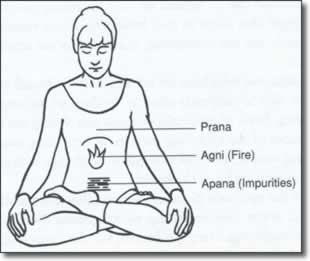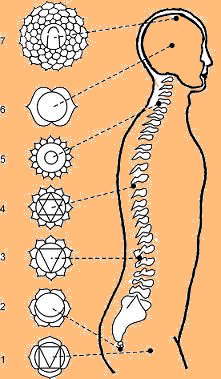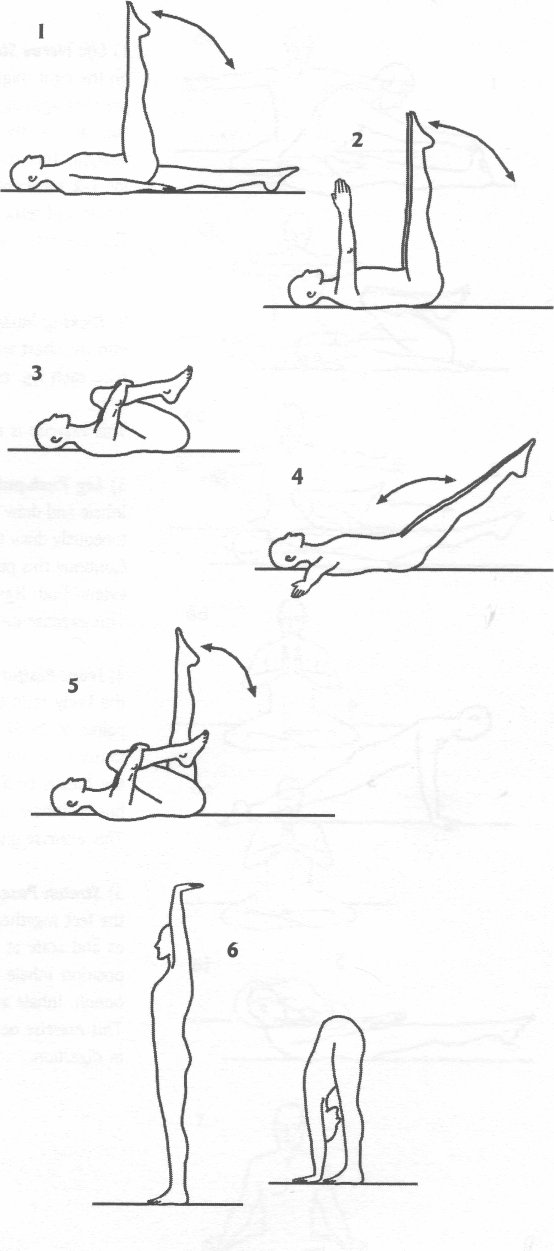Simple Kriya Pranayama:
Breath is the life force that sustains our life. Human body is physical manifestation of one’s consciousness and in that, primarily, Central Nervous System (brain and spinal cord) is densely concentrated with abundant consciousness. So, all the yoga practices always revolve around CNS with an intention being to grow ones awareness towards consciousness. Kriya Pranayama practices focus on getting the glowing awareness of main three Nadis (Ida, Pingala & Sushumna) and seven Chakras (Mooladhara, Swadhistana, Manipura, Anahata, Vishudhi, Ajna & Sahasrara) and opening them for the free flow of Prana. There are variations in the techniques. But, all have the same goal “to get the realization of the self”. Kriya pranayama is the most important technique of Kriya Yoga.
You must practice few techniques at a time for sometime and get mastery in it before moving onto next techniques. Do not attempt to master everything in one day. It should be mastered only gradually.
Benefits of Kriya Pranayama
- Pranayama teaches the “proper” way to breathe. Instead of breathing from our chest and under-using our lungs, you can increase the capacity of your lungs by breathing slowly and deeply.
- Pranayama helps reduce the toxins and wastes that accumulate within your body, and may act as a preventative for illness.
- Pranayama is helpful for digestion; learning to breathe properly helps improve metabolism.
- The concentration and focus required to effectively practice yoga breathing exercise methods helps improve self-control and willpower.
- Pranayama repels stress and allows the body to relax.
- When the body is relaxed and the mind is focused, yoga breathing exercise methods allow for a more fulfilling spiritual journey.
Groundwork for Kriya Pranayama
- Sit in a comfortable position, without having external support for back. Let the spine stay in natural S curve. Take a few slow and deep breaths and relax.
- During the entire course of Pranayama, let your breath follow natural rhythm. Do not force to hold the breath or struggle to keep the breath slow.
- During the entire course of Pranayama, if for any reason you lost control of your awareness then do not worry or struggle to forcibly bring the awareness back to from where it left from the practice. Instead, let go of the situation, and easily start all over again without worrying that something happened.
- Always do abdominal breathing (breath using diaphragm). Abdominal breathing relaxes and calms the mind. This is the natural way of breathing. Observe how baby breaths! Contrary to that, breathing using upper chest will create anxiety and high blood pressure.
- Curl up your tongue to form Kechari Mudra (Khechari Mudra). After few thousand hours of practice, tongue will naturally enter the nasal pharynx and into the nasal septum. This is king of mudras. Kechari Mudra will bring mental stillness, mind will naturally calm down. One should be in Kechari Mudra throughout the practice.
Mental Kriya Pranayama
Mentally move your awareness from Mooladhara Chakra to Sahasrara slowly, mentally touchingeach chakra in the upward path. Stay a while for a comfortable duration at Sahasrara and then slowly move your awareness from Sahasrara to Mooladhara Chakra while mentally touching each chakra in the downward path. This completes one mental Pranayama.
Repeat this Pranayama few times daily for some days till you are comfortable in tracing and visualizing the paths up and down. After getting complete mastery over this, move onto the Kriya Pranayama.
Variations of Mental Pranayama
- Visualize a narrow hollow white tube running from Mooladhara to Sahasrara. Visualize all the seven Chakras on it (Mooladhara – Red four petal lotus, Swadhistana – Orange six petal lotus, Manipura – Yellow ten petal lotus, Anahata – Green twelve petal lotus, Vishudhi – Blue sixteen petal lotus, Ajna – Indigo two petal lotus and Sahasrara – Violet & White thousand petal lotus). Do the mental Pranayama along with these visualizations tracing the path up and down the white tube while mentally touching all the Chakras in the path.
- While doing Pranayama, mentally chant OM (AUM) at each Chakra in the path. You can as well use the Bija mantras of the chakras or mantras of deities.
- Visualize the smooth candle flame (about an inch in length) going up and down the white tube while mentally tracing the path.
- Visualize the smooth & bright Sun (soothing white Sun) going up and down the white tube while mentally tracing the path.
Kriya Pranayama Cycle
Inhale, and while inhaling move your awareness from Mooladhara Chakra to Sahasrara, mentally touching each chakra with mantra in the upward path. Stay a while for a comfortable duration at Sahasrara while chanting the mantra and then exhale slowly. While exhaling, move your awareness from Sahasrara to Mooladhara Chakra mentally touching each chakra with mantra in the downward path. Mantra can be OM (AUM), Bija mantra or name of your beloved Deity.
While exhaling, contract the lower throat/glottis so as to create the resistance to the outgoing breath. This will make the duration of exhale lengthier compared to inhale and help in opening the spiritual (third) eye.
This completes one Cycle of Kriya Pranayama.
Variations Visual Kriya Pranayama
- Visualize Sushumna nadi as narrow hollow white tube running from Mooladhara to Sahasrara. Visualize all the seven Chakras in Sushumna nadi (Mooladhara – Red four petal lotus, Swadhistana – Orange six petal lotus, Manipura – Yellow ten petal lotus, Anahata – Green twelve petal lotus, Vishudhi – Blue sixteen petal lotus, Ajna – Indigo two petal lotus and Sahasrara – Violet & White thousand petal lotus). Do the Kriya Pranayama along with these visualizations.
- Visualize the smooth candle flame (about an inch in length) going up and down the Sushumna nadi while doing Kriya Pranayama.
- Visualize the smooth white ball (about an inch in diameter). While inhaling and going up the Sushumna, white ball increases its size gradually. While exhaling and coming down the Sushumna, white ball decreases its size gradually.
- While inhaling and going up, trace the dorsal side of the Sushumna nadi. While exhaling and coming down, trace the ventral side of the Sushumna nadi. (Dorsal side is towards the back side of the body and ventral side is towards front).
- Visualize two narrow hollow white tubes running on left and right of the Sushumna nadi. One on the left is Ida nadi and the one on the right is Pingala nadi. Inhale and move awareness from Mooladhara to Sahasrara thru Ida nadi. After reaching Sahasrara, keep awareness there as long as possible to keep comfortably. Exhale and move awareness from Sahasrara to Mooladhara thru Pingala nadi.
- While inhaling, imagine cool air is entering your body, gradually filling your body from Mooladhara to Sahasrara. While exhaling, imagine hot air is going out gradually from Sahasrara to Mooladhara.
- With repeated practice, one will gain mastery over breath and mind. Exhale will take more time than inhale and, each breath will span over a minute. Mind will rest in peace. This is the time to move on to next step.



 Follow
Follow